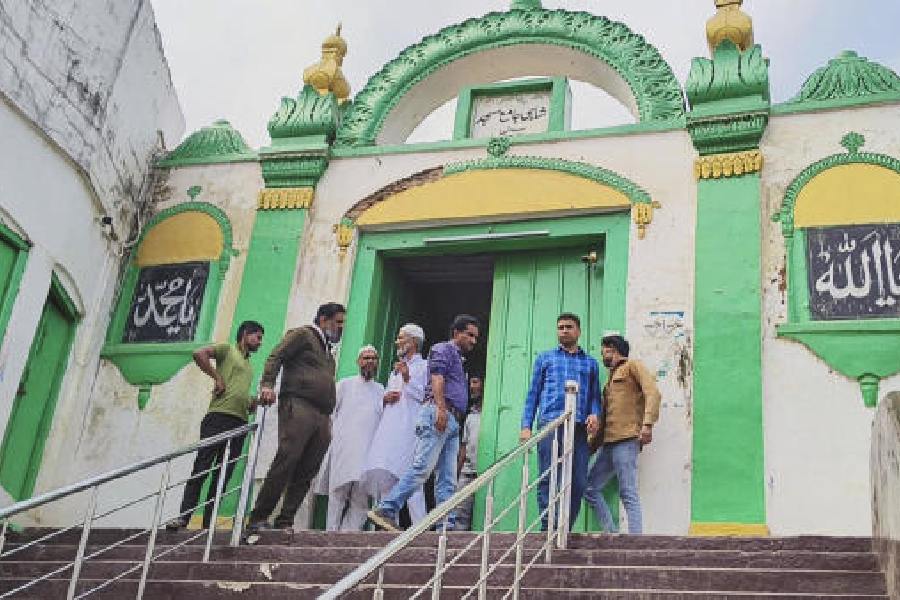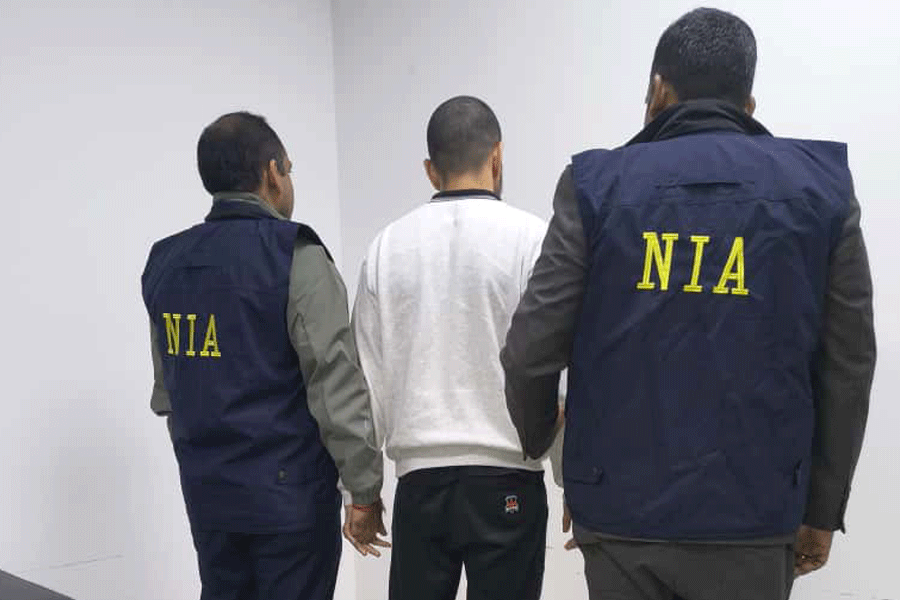 |
| Vimanika Comics’ Karan Vir Arora is clear that he’s selling “passion”, not comics . Pix: Gajanan Dudhalkar |
What happens when a mysterious virus attack that reduces its victims to feral savages breaks out in Bangalore? Will the lone R&AW agent who enters the city find any survivors, and can he beat the odds and come up with a cure? Or, will the city succumb to the attack of the zombies?
Or would you rather follow the storyboard of young Kalki, a seemingly average teenager who hunts modern-day demons at night. Is this the return of Kalki, the tenth incarnation of Lord Vishnu? And can he tame the dangerous demons who are stalking the world.
Forget alien superheroes in underwear. Forget even the epics — as you’ve known them so far. The storyboard’s exploding as a host of new comic book publishers are creating a graphic new world of Indian comics. “There’s a renewed interest in comics,” says Suhas Sundar, partner, Level 10 Studios.
The new players are determined to prove that comics aren’t meant for children alone and that they can produce world-class comics in India. So they’re coming up with fresh tales to reach a growing base of readers.
Consider this. In the last three years, publishers like Vimanika, Campfire, Arkin Comics, Level 10 and Manta Ray have entered the frame. Three months ago, comic book “fanatic” Jatin Varma launched Pop Culture Publishing. Later this month, comic book artist Vivek Goel will launch his imprint Holy Cow Entertainment. And others are coming too.
 |
| Comic book artist Vivek Goel is excited about launching his own publishing firm Holy Cow Entertainment Pix: Gajanan Dudhalkar |
The online world of webcomics has caught the buzz too with a bunch of youngsters illustrating their take on their life and times.
The new publishers are producing everything from serialised comics to magazines to graphic novels. There’s even a self-published 250-page anthology, Comix India. Campfire began by retelling classics like Charles Dickens’ Oliver Twist in graphic form. And Vimanika is focused on mythological tales like I Am Kalki. Level 10 wants to tell comic stories in every genre from sci-fi to horror as long as they’re set in India while Manta Ray is dealing in realistic tales. And Comix India’s Bharath M. is even doing non- fiction comics. “Comix India is a platform for independent creators,” he says.
The players are confident of the genre’s growth. After all, the country’s first comic convention, Comic Con India, held in February, drew over 15,000 footfalls over two days with visitors even dressing like comic characters. Vimanika and Level 10 ran out of stocks by the second afternoon while Campfire did total sales of around Rs 1.5 lakh.
 |
 |
| Jatin Varma, who hosted the highly successful Comic Con India, has taken the plunge into publishing with titles like Uud Bilaw Manus |
“It was a great success. And it got the ball rolling for comics in India once again,” says Varma, whose firm Twenty Onwards Media organised the event. Adds Andrew Dodd, editor-in-chief, Campfire: “The recent steady growth in the medium’s popularity, culminating in such a successful Comic Con, feels like the start of a renaissance for comics in this part of the world.”
True, Indian comics are still defined by Amar Chitra Katha, and homegrown superheroes like Diamond Comics’s Chacha Chaudhary or Raj Comics’s Super Commando Dhruv. ACK Media, Diamond and Raj dominate the estimated Rs 100-crore market. But the new publishers are keen to move the story forward.
“We’re selling passion, not comics,” says Karan Vir Arora, who founded Vimanika Comics in 2007. For Arora, it all began with the mythological tales he grew up hearing. Now, he wants to retell them through Vimanika.
Like the other entrepreneurs, Arora was inspired by Virgin Comics, which reinvented Indian comics in the 2000s — with the rise of satellite television, comic books had started losing their popularity in the 1990s. Virgin came in and took over Gotham Comics started by Deepak Chopra and his son Gotham.
Virgin shut down in 2008 and now has a new avatar Liquid Comics. But it changed the game by bringing in international titles and also by showing that Indian artists and writers could create comics like Devi and Ramayan 3392 A.D for international audiences. Says Shamik Dasgupta, who wrote Ramayan 3392 A.D.: “Virgin showed that one can do good comics here.”
For Vimanika’s Arora, the opportunity was clear. “Amar Chitra Katha had well-researched stories but the art was flat while Virgin had beautiful art but not authentic stories. So I said let’s combine the two,” he recounts. Vimanika has released 12 comics since 2008 including The Sixth: The Legend of Karna. Now, there’s I Am Kalki and a series on Shiva is coming up too.
 |
 |
| Shamik Dasgupta, who wrote the hit Ramayan 3392 A.D., feels the common perception of Indian comics is set to change. Pic By : Gajanan Dudhalkar |
Like Vimanika, Campfire’s also delved into mythology with its recent releases like Sita: Daughter of the Earth. Founded by Delhi-based businessman Keshav Thirani in end-2007, Campfire began by rendering classics into graphic novels. “We thought a good way to establish a new brand would be to use existing material,” says Dodd.
Campfire has since ventured into mythology, biographies and original titles like the retelling of Ali Baba and the Forty Thieves in present-day Mumbai. It’s released 51 titles since end-2008, and has a steady pipeline. Coming up are “contemporary retellings” of Ravana and Draupadi.
Not everyone’s keen on mythology alone but they’re catering to adult readers too. Like Level 10 Studios, founded in 2009 by IT professional Suhas Sundar and Shreyas Srinvas, who used to work with Hindustan Unilever. “We felt nobody was doing comics for adults in India. So we decided to take a stab at it,” says Sundar.
Level 10 publishes Comic Jump, an anthology magazine that carries three serialised stories. It has published nine issues since May 2010. Sundar feels the format allows them to explore a wider variety. “We’re casting the net wide to reach every kind of reader,” he says. So Shaurya, its “take on superheroes without costumes”, is popular with young readers. Then, there’s The Rabhas Incident, written by Sundar, which is about a virus outbreak and which has been a hit with comic buffs. “Earlier, people felt there’s no market for such content. But the response has shown that people want something different,” says Sundar.
He’s also constantly refreshing the appeal. So The Rabhas Incident, which concludes soon, will be replaced by Daksh, written by Dasgupta. It’s about Yama’s son, who’s banished from Hell after he causes 100 souls to escape. “It’s India’s answer to dark superheroes like Batman,” says Dasgupta, who’s now joined a new comic book start-up, which he believes “will change the perception of Indian comics”.
 |
 |
| Manta Ray’s Pratheek Thomas wants to show that comics can tell realistic and dark stories too as in their titles like Hush, illustrated by Rajiv Eipe (above), and the forthcoming Twelve |
Meanwhile, Manta Ray’s already showing that comics can deal in realistic themes. “In India, there’s this perception that comics can only be about fantasy, mythology and action. But we want to show that you can tell other stories that are dark and real and still interesting,” says Pratheek Thomas, who founded Manta Ray with his design school friend Dileep Cherian in 2009.
Their first title, Hush, is a stark black & white graphic novel about child abuse. Astonishingly, it has no dialogue at all. “Hush has done exceptionally well in stores,” says Thomas. Next up is Twelve, a monthly series of 12 graphic short stories. “Our focus is on telling real stories that our audience of 18 to 35-year-olds can relate to,” says Thomas.
The comic book resurgence is also throwing up fresh opportunities. So Pop Culture Publishing’s Varma wants “to provide a platform for young talent.” He’s already released three titles — and has another seven lined up. There’s Adhiraj Singh’s Uud Bilaw Manus about a half-man, half-otter Bhojpuri superhero, and Sumit Kumar’s The Itch You Can’t Scratch, a funny account of his own bumbling journey from childhood through engineering college to comics. Says Kumar: “We all have an itch that we want to pursue. At one time, I decided to scratch all the itches I have and it’s about how I went about doing that.”
Meanwhile, comic book artist Vivek Goel had so many stories to narrate that he decided to turn publisher with Holy Cow Entertainment. He’s relying on his experience of working with everyone from Raj Comics to Level 10 to succeed. “I always wanted to change the face of Indian comics, and I hope to do that with Holy Cow,” says Goel, who’s illustrated two international covers of Phantom for Moonstone Books.
Holy Cow will first launch Were-House, a black & white anthology on three shape-shifting animals, in May. Goel’s not talking were-wolves though, but has created a were-dhol (Indian wild dog), were-leopard and were-rat. “My art is very dark,” he says. But he’s more excited about the 10-issue series, Ravanayan, which he’ll release in July. “Not much is known about Ravana except a few basics. So I’ve re-imagined his life before he abducts Sita. Ravanayan will give my company the platform it needs to take off,” feels Goel, who prefers working in black & white.
 |
| Titles like The Rabhas Incident from Level 10 and Sita: Daughter of the Earth from Campfire are setting new standards in Indian comics |
If the new players are reinvigorating Indian comics, the existing majors are ramping up too. For instance, Diamond Comics is launching comics in south Indian languages. And it’s working on a 24-hour channel too. “It will be based entirely on Indian content,” says Gulshan Rai, managing director, Diamond Comics. ACK Media (which publishes Amar Chitra Katha) already has a show on Cartoon Network, and is releasing more titles too.
Yet, there are challenges ahead. Goel feels the biggest challenge for the new entrants is to “make their books available regularly”. That’s why he’s lined up releases till 2012. The new publishers though are focusing on English comics in the metros. But the Indian market exists elsewhere. Rai says that 90 per cent of Diamond Comics’ sales come from the hinterland, and only 20 per cent come from English comics. That’s why Campfire’s doing its mythological comics in Hindi and English.
The other big challenge is distribution. While the entrenched players reach Tier 2 and 3 towns, the new ones are struggling for visibility in the metros. Distribution is what caused Rohan Kapadia’s Arkin Comics to stumble too.
Kapadia, 23, founded Arkin as a student in 2007. He began with custom comics — or comics that used a customer’s picture to feature him as a superhero. Last year, he ventured into original stories like Irith, written by Dasgupta — it’s about a taskforce of superheroes who can trace their bloodline to ancient Indian warriors. But two issues into the five-issue series, Kapadia had to hit the brakes as the books weren’t reaching stores. “Distribution is not letting the comic book industry grow,” he says.
He’s now releasing Irith as a graphic novel this summer. And he’s even considering releasing his next title, Tikshna, about a female assassin in Pataliputra 260 B.C., in Singapore. Indeed, all the new publishers are looking beyond India to survive. Campfire’s largest market is the US while Vimanika’s getting into UK. Of course, the new players are still in start-up mode. They know they have to be patient for growth at home. But they’re confident that the opportunity’s huge. And that the storyboard will only explode.










